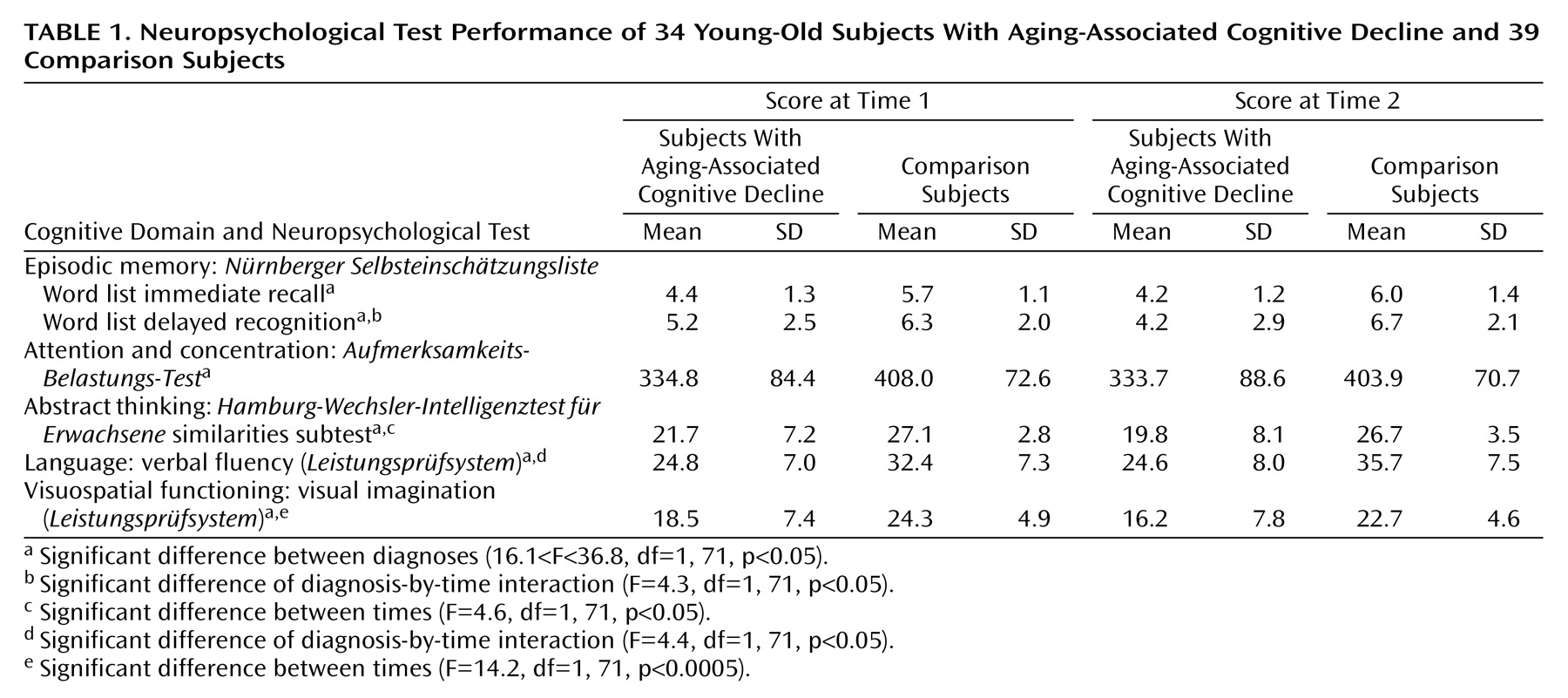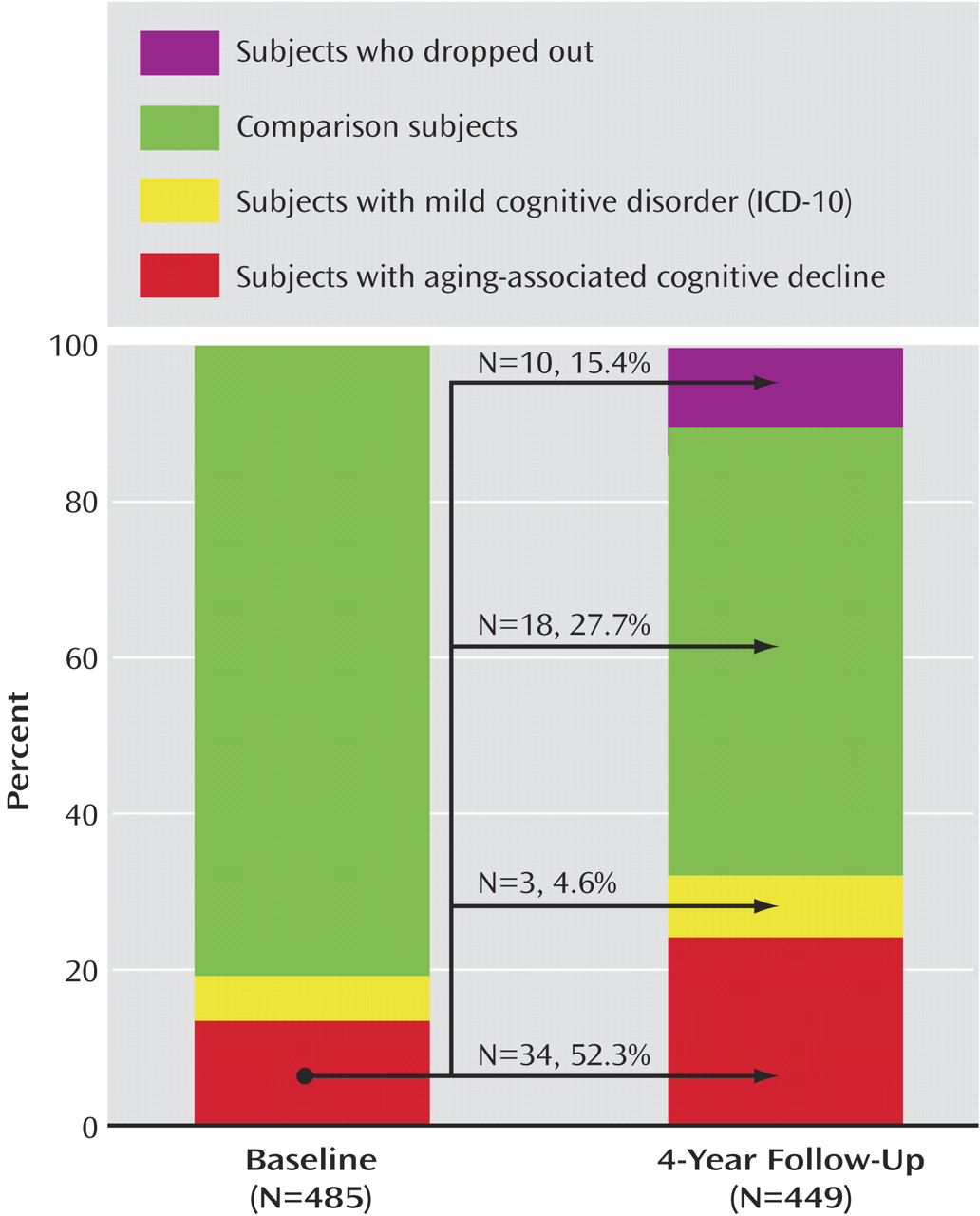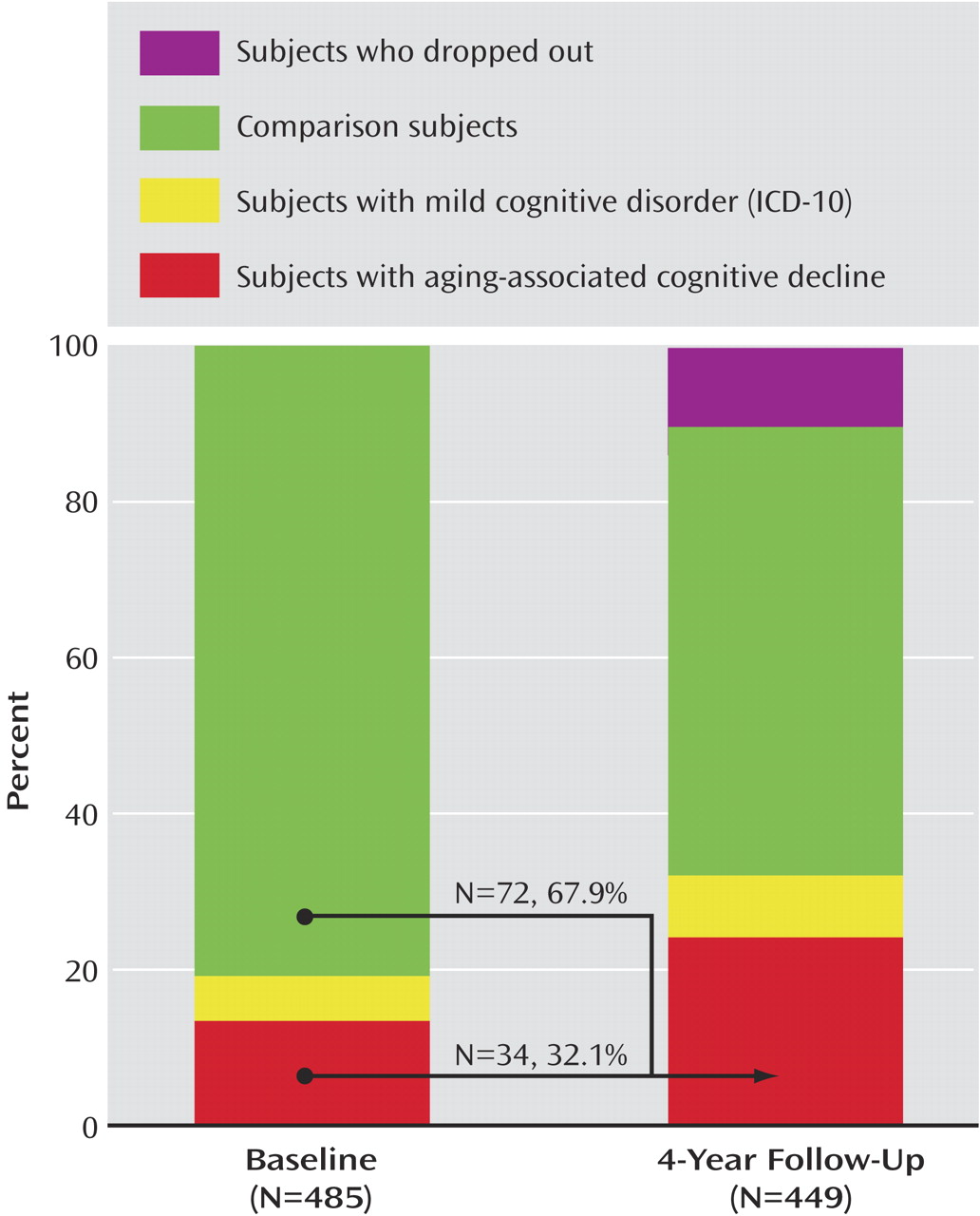To date, various research diagnostic criteria as well as clinical manuals have been proposed to further define mild cognitive impairment
(2,
6,
7). Those include age-associated memory impairment
(8) and its modifications: age-consistent memory impairment
(9) and late-life forgetfulness
(9), the amnestic variant of mild cognitive impairment introduced by Petersen and colleagues (mild cognitive impairment, amnestic)
(10), and the ICD-10 criteria of “mild cognitive disorder.” To meet some of the limitations affecting earlier attempts to define mild cognitive impairment, a working party of the International Psychogeriatric Association introduced the concept of “aging-associated cognitive decline”
(11). In contrast to most previous concepts, aging-associated cognitive decline not only uses age- and educational-adjusted normal levels to define a cognitive deficit but also considers decline in a broader potential range of cognitive domains, namely, memory and learning, attention and concentration, thinking, language, and visuospatial functioning. This agrees with the hypothesis that not only mnestic but also language deficits, such as verbal fluency impairment, might indicate further cognitive decline
(12).
Accordingly, the aims of the present study were twofold: 1) to establish prevalence rates for mild cognitive impairment according to criteria for aging-associated cognitive decline within a population-based sample of young-old individuals and 2) to investigate the longitudinal course of this condition, particularly with respect to its temporal stability, neuropsychological test performance, and conversion to dementia.
Results
At time 1, subjective complaints about cognitive decline were found in 226 subjects (46.6%), and 200 subjects (41.2%) scored below one standard deviation of age- and education-adjusted normal values on at least one of the cognitive tests applied. Ninety-two subjects (19.0%) of the total sample suffered from medical and/or neuropsychiatric conditions with a potential causative relation to cognitive decline. When diagnostic criteria were applied to these findings, 65 subjects (13.4%) fulfilled the criteria for aging-associated cognitive decline. Additionally, 28 subjects (5.8%) had evidence of subjective and objective cognitive impairment but simultaneously met the exclusion criteria of aging-associated cognitive decline. Those were classified as suffering from mild cognitive disorder. None of the investigated participants was diagnosed as suffering from dementia according to the DSM-IV criteria; data sets from 15 subjects had to be excluded owing to missing values.
At time 2, after a follow-up period of 4 years, 449 subjects, or 89.8% of the original sample, could be reexamined. Twenty subjects had died. Other reasons for dropout (N=31) were severe physical handicaps that would make the investigation too troublesome, lost of interest/motivation, having moved to other places in the country, or no reason given for refusal. Dropout rates were highest in the subjects with aging-associated cognitive decline, followed by those fulfilling ICD-10 criteria for mild cognitive disorder, and then comparison subjects (15.4%, 14.3%, and 7.6%, respectively); however, these differences did not reach statistical significance (χ2=3.2, df=2, n.s.). Among the subjects who were reexamined at time 2, the prevalence rate of aging-associated cognitive decline increased to 23.6% (N=106). An additional 7.8% of the subjects (N=35) fulfilled the ICD-10 criteria for mild cognitive disorder. None of the reexamined subjects had developed dementia during the 4-year follow-up.
Of the subjects diagnosed with aging-associated cognitive decline at time 1, 34 (52.3%) retained the diagnosis at follow-up (
Figure 1). Two subjects (3.1%) no longer complained about cognitive decline, and in another three subjects (4.6%), a severe medical condition sufficient to cause cognitive dysfunction had become apparent during the follow-up period. Both conditions led to an exclusion from the group with aging-associated cognitive decline. In contrast, 15 subjects (23.1%) of the original group with aging-associated cognitive decline performed within normal limits (one standard deviation) on cognitive testing at the follow-up, despite persisting complaints about cognitive decline. Another subject classified as having aging-associated cognitive decline at time 1 had no subjective or objective cognitive deficits (1.5%). Ten subjects (15.4%) who were initially diagnosed with aging-associated cognitive decline dropped out and could not be reexamined at time 2. Of the 207 subjects with subjective complaints at baseline, 172 reproduced their complaints at follow-up.
Although four of the 28 subjects who initially fulfilled criteria for mild cognitive disorder could not be reexamined, seven of them no longer demonstrated cognitive impairment at follow-up. Among those, two subjects no longer reported subjective complaints, whereas five performed at normal levels in all tests applied.
At time 2, 72 new cases of aging-associated cognitive decline were identified (
Figure 2). Among those, 17 had been found to be unimpaired on cognitive testing at time 1, although 20 of them had already complained about cognitive decline at the time of the first examination. Another 35 incidence patients with aging-associated cognitive decline had previously been impaired on cognitive testing but did not fulfill the subjective criteria at time 1.
At time 1, the majority of subjects with aging-associated cognitive decline demonstrated cognitive deficits on one or two (N=28, 82.3%) neuropsychological tests, whereas deficits in three or four (N=6, 17.7%) domains were less frequent. At time 2, the proportion of subjects with aging-associated cognitive decline who were impaired on one or two (N=22, 64.7%) tests had lower ratings, whereas more subjects showed deficits in three or more domains (N=12, 35.3%) (χ2=2.7, df=1, p=0.09).
The prevalence of isolated mnestic deficits according to “mild cognitive impairment, amnestic”
(10) was rather low. The respective criteria were applied for 4.1% of the subjects at time 1 and 4.2% at time 2, respectively. A total of 27.8% (N=5) of the subjects who fulfilled the criteria for “mild cognitive impairment, amnestic” at time 1 could be reclassified accordingly at time 2.
In a further step, the development of performance across different cognitive domains during the follow-up period was compared between subjects who retained the diagnosis of aging-associated cognitive decline from time 1 to time 2 (N=34) and comparison subjects who were cognitively unimpaired both at time 1 and time 2 (N=39) (
Table 1). According to the ANOVAs calculated, the subjects with aging-associated cognitive decline were significantly impaired on all cognitive tests applied in relation to the comparison subjects (word list immediate recall—diagnosis main effect: F=39.2, df=1, 71, p<0.0005; time main effect: F=0.3 df=1, 71, p=0.60; word list delayed recognition—diagnosis main effect: F=16.8, df=1, 71, p<0.0005; time main effect: F=0.5, df=1, 71, p=0.50;
Aufmerksamkeits-Belastungs-Test [attention and concentration]—diagnosis main effect: F=16.1, df=1, 69, p<0.0005; time main effect: F=0.2, df=1, 69, p=0.60;
Hamburg-Wechsler-Intelligenztest für Erwachsene similarities subtest [abstract thinking]—diagnosis main effect: F=24.8, df=1, 71, p<0.0005; time main effect: F=4.6, df=1, 71, p<0.05; verbal fluency—diagnosis main effect: F=36.8, df=1, 71, p<0.0005; time main effect: F=3.5, df=1, 71, p=0.06; and visual imagination—diagnosis main effect: F=19.8, df=1, 71, p<0.0005; time main effect: F=14.2, df=1, 71, p<0.0005).
Additionally, the subjects with aging-associated cognitive decline showed a significant decline in performance on the delayed word recognition task in relation to the comparison subjects during the follow-up, as demonstrated by a significant diagnosis-by-time interaction (word list delayed recognition—diagnosis-by-time interaction: F=4.3, df=1, 71, p<0.05). The respective interaction for verbal fluency also reached the significance level (verbal fluency—diagnosis-by-time interaction: F=4.4, df=1, 71, p<0.05). However, this effect resulted from an increased performance in the comparison subjects, whereas the subjects with aging-associated cognitive decline showed rather stable values. None of the other interactions for the remaining neuropsychological test scores addressing immediate recall, attention and concentration, abstract thinking, and visuospatial functioning reached significance (0.1<F<2.9, df=1, 71).
In relation to the comparison subjects, the subjects with aging-associated cognitive decline demonstrated significantly (diagnosis main effect: F=24.4, df=1, 71, p<0.005) more mild depressive symptoms at time 1 (Self-Rating Depression Scale score—subjects with aging-associated cognitive decline: mean=37.7, SD=7.8; comparison subjects: mean=30.3, SD=5.6) and time 2 (Self-Rating Depression Scale score—subjects with aging-associated cognitive decline: mean=38.0, SD=7.5; comparison subjects: mean=30.4, SD=5.7). Similar results were obtained when all subjects diagnosed with aging-associated cognitive decline at time 2 (N=106) were compared with all cognitively unimpaired comparison subjects at time 2 (N=245).
Discussion
According to our findings, aging-associated cognitive decline represents a frequent condition affecting 13.4% of the 60–64-year-old population. In addition, the prevalence of aging-associated cognitive decline showed an age-related increase that rose to 23.6% within a 4-year follow-up period. The established prevalence rates are in line with the results from previous population-based studies that applied the criteria for aging-associated cognitive decline
(13–
15). However, although previous investigations mainly focused on subjects in their 70s and 80s, our study for the first time, to our knowledge, indicates that aging-associated cognitive decline is also common in the population of young-old. Because all subjects underwent a thorough physical examination, the prevalence rates of aging-associated cognitive decline in the present study may not be attributed to the early effects of severe systemic or neurological disorders.
Furthermore, the diagnosis of aging-associated cognitive decline was characterized by a relatively high temporal stability. This finding emphasizes the existence of a distinct diagnostic entity, such as mild cognitive impairment, that has been challenged
(24,
25). It has been argued that mild cognitive impairments might considerably fluctuate over time and would not be suitable to define a circumscribed diagnostic category. Indeed, several population-based studies revealed that, in particular, the amnestic form of mild cognitive impairment (mild cognitive impairment, amnestic)
(10) was rather unstable over time, in that only about 7% of the affected subjects were still classified under this category after 2 to 3 years, whereas more than 40% reverted to normal
(14,
25). This is in contrast to our finding that 52.3% of the subjects with a baseline diagnosis of aging-associated cognitive decline retained the diagnosis at follow-up. Furthermore, 6.2% had persisting deficits in cognitive tests, although they had to be excluded from the group with aging-associated cognitive decline for other reasons (lack of subjective complaints, severe medical conditions). Only 23.1% of the original subjects with aging-associated cognitive decline improved with respect to cognitive testing. A single person (1.5%) reverted to normal, insofar as he was neither subjectively nor objectively impaired at follow-up. Similar data were reported by Ritchie et al.
(14), who found that 50%–60% of the subjects classified as having aging-associated cognitive decline retained this diagnosis when they were reexamined after 1 year. Taken together, these findings indicate that in contrast to other concepts of mild cognitive impairment, aging-associated cognitive decline defines a distinct syndrome that is reproducible over time in a considerable proportion of elderly subjects.
In relation to the comparison subjects, a significantly larger percentage of subjects with aging-associated cognitive decline suffered from mild depressive symptoms. Because patients with manifest depression were excluded from the group with aging-associated cognitive decline, cognitive impairment due to affective disorders did not contribute to this finding. Otherwise, in patients with manifest dementia, depressive symptoms and apathy often overlap, making it difficult to differentiate depressive disorder comorbidity in dementia. Thus, mild depressive symptoms in aging-associated cognitive decline might represent an epiphenomenon of increasing cognitive decline.
In our population of the young-old, aging-associated cognitive decline did not predict conversion to dementia within a 4-year follow-up period. Ritchie et al.
(14) and Busse et al.
(15) determined conversion rates of 28% and 47% within a comparable time interval, respectively. However, the investigated population in these studies was considerably older. Dropout rates were highest in subjects with aging-associated cognitive decline, followed by those fulfilling ICD-10 criteria for mild cognitive disorder, and then comparison subjects, and it is likely that at least some of the subjects with aging-associated cognitive decline might have converted into dementia. However, we could not definitely prove this assumption. Nevertheless, other factors must be considered to explain this discrepancy. In particular, length of the follow-up interval has to be weighed against the age of the subjects. Previous studies on cognitive deficits in preclinical Alzheimer’s disease have revealed some empirical evidence that deficits across multiple cognitive domains are apparent not only years but even decades before the diagnosis of dementia can be made
(26) and that the magnitude of those preclinical cognitive deficits appears to be relatively stable until a few years before the clinical diagnosis is made
(1). Consequently, the likelihood of observing accelerated changes in cognitive performance among incident Alzheimer’s disease increases as time before the eventual diagnosis decreases. When we take into account that the incidence and prevalence of dementia are relatively low during the seventh decade of life but increase exponentially from the age of 70, the divergent results with respect to conversion rates might mainly be explained by age differences between the studied populations. Accordingly, our results suggest that age and length of follow-up interval are of crucial relevance when the predictive validity of different concepts of mild cognitive impairment is assessed.
Nonetheless, longitudinal analysis of our data indicates that the respective neuropsychological deficits follow a progressive course. At time 2, the subjects with aging-associated cognitive decline were impaired on more neuropsychological tests than at time 1. This observation is in line with the assumption that the putative pathological process involved a broader range of cognitive domains during the follow-up period. In relation to comparison subjects, the subjects with aging-associated cognitive decline deteriorated significantly during follow-up in the test on delayed word recognition. In contrast, performance on immediate recall remained rather stable in the subjects with aging-associated cognitive decline or improved slightly in the comparison subjects. Obviously, the slight performance gains observed in the comparison group in this cognitive domain, as well as with respect to delayed recognition and verbal fluency, may refer to an increased awareness of the participants of the study toward their neuropsychological performance. Moreover, the double dissociation found between immediate and delayed verbal memory argues against an effect of other conditions, such as depressive syndromes, that should affect both recall conditions simultaneously.
Several previous studies have addressed the question of whether deficits in specific cognitive domains predict the development of Alzheimer’s disease
(26–
31). They all agreed that, in particular, deficits with respect to episodic memory tasks but also, to a lesser degree, other cognitive dysfunctions are associated with an increased risk of further cognitive decline. Notably, Palmer et al.
(30) also found that specific tests of word recall and verbal fluency had positive predictive value for dementia. These findings are paralleled by the results of recent neuroimaging studies. Pantel et al.
(32) demonstrated (in a subsample of the subjects with aging-associated cognitive decline investigated here) atrophic changes of medial temporal lobe structures that are specifically involved in episodic memory function. Similar findings were obtained in a variety of previous neuroimaging studies in patients with manifest Alzheimer’s disease (for a review, see references
33 and
34).
In conclusion, we show that aging-associated cognitive decline is a frequent condition in community-dwelling young-old subjects. The prevalence of aging-associated cognitive decline increased with age, and the diagnosis of aging-associated cognitive decline was characterized by a rather high temporal stability. However, in this particular sample of young-old subjects, aging-associated cognitive decline did not predict dementia during a 4-year follow-up period. The subjects with aging-associated cognitive decline were characterized by a selective further decline of episodic memory that occurred independently from physical comorbidity.




